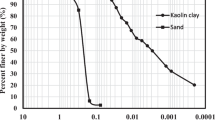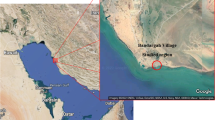Abstract
In this paper, the geotechnical properties of sandy soil stabilized using cement and prosopis juliflora fibers have been studied. Abundant availability, superior mechanical properties and low energy consumption for processing make prosopis juliflora fibers an ideal choice for soil stabilization. In the present study, the fibers used were at 0.0, 0.25, 0.50, 0.75 and 1.0% by weight of the soil and the amount of cement used was kept constant as 9%. Among all the trials, the combination of 9% cement and 1% fibers was found to yield optimum results. In this combination, the shear strength of natural soil increases up to 2.36 times, the angle of internal friction increases from 47° to 68° and the CBR value increases by 68.19%. The most remarkable effect observed due to the fiber inclusion was the change in the behavior of cemented soil from brittle to ductile.
Access this chapter
Tax calculation will be finalised at checkout
Purchases are for personal use only
Similar content being viewed by others
References
Yadav, J.S., Tiwari, S.K.: A study on the potential utilization of crumb rubber in cement treated soft clay. J. Build. Eng. 9, 177–191 (2017)
Yadav, J.S., Tiwari, S.K., Shekhwat, P.: Strength behavior of clayey soil mixed with pond ash, cement and randomly distributed fibers. Transp. Infrastruct. Geotechnol., 1–19 (2018)
Burkart, A.: A monograph on the genus Prosopis (Leguminosae subfam. Mimosoideae). (Part 1 and 2). Catalogue of the recognized species of Prosopis. J. Arnold Arboretum 57, 219–249, 450–525 (1976)
Saravanakumar, S.S., Kumaravel, A., Nagarajan, T., Sudhakard, P., Baskaran, R.: Characterization of a novel natural cellulosic fiber from Prosopis juliflora bark. Carbohyd. Polym. 92, 1928–1933 (2013)
ASTM D2487-17: Standard Practice for Classification of Soils for Engineering Purposes (Unified Soil Classification System). ASTM International, West Conshohocken, PA (2017)
IS. 2720-26: Determination of Water Content-Dry Density Relation Using Light Compaction. Bureau of Indian Standards publications, New Delhi (1985)
IS. 2720-13: Determination of Direct Shear Strength. Bureau of Indian Standards Publications, New Delhi (1986)
IS. 2720-16: Indian standard for Laboratory Determination of CBR. Bureau of Indian Standards Publications, New Delhi (1997)
IS. 2720-15. Indian Standard for Laboratory Determination of Consolidation Properties. Bureau of Indian Standards Publications, New Delhi (1986)
Consoli, N.C., Vendruscolo, M.A., Fonini, A., Rosa, F.D.: Fiber reinforcement effects on sand considering a wide cementation range. Geotext. Geomembr. 27, 196–203 (2009)
Yadav, J.S., Tiwari, S.K.: Behavior of cement stabilized treated coir fiber reinforced clay-pond ash mixtures. J. Build. Eng. 8, 131–140 (2016)
Gray, D.H., Asce, A.M., Ohashi, H.: Mechanics of fiber reinforcement in sand. J. Geotech. Eng. 109(3), 335–353 (1983)
Consoli, N.C., Prietto, P.D.M., Ulbrich, L.A.: Influence of fiber and cement addition on behavior of sandy soil. J. Geotech. Geoenviron. Eng. 124(12), 1211–1214
Yadav, J.S., Tiwari, S.K.: Effect of waste rubber fibers on the geotechnical properties of clay stabilized with cement. Appl. Clay Sci. 149, 97–110 (2017)
Author information
Authors and Affiliations
Corresponding author
Editor information
Editors and Affiliations
Rights and permissions
Copyright information
© 2019 Springer Nature Switzerland AG
About this paper
Cite this paper
Rudramurthy, G., Ramasamy, P., Rajendran, A. (2019). Geotechnical Properties of Sandy Soil Stabilized Using Cement and Prosopis juliflora Fibers. In: Kallel, A., et al. Recent Advances in Geo-Environmental Engineering, Geomechanics and Geotechnics, and Geohazards. CAJG 2018. Advances in Science, Technology & Innovation. Springer, Cham. https://doi.org/10.1007/978-3-030-01665-4_65
Download citation
DOI: https://doi.org/10.1007/978-3-030-01665-4_65
Published:
Publisher Name: Springer, Cham
Print ISBN: 978-3-030-01664-7
Online ISBN: 978-3-030-01665-4
eBook Packages: Earth and Environmental ScienceEarth and Environmental Science (R0)




